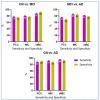Classification of Alzheimer's Disease Using Maximal Information Coefficient-Based Functional Connectivity with an Extreme Learning Machine
- PMID: 37508978
- PMCID: PMC10377329
- DOI: 10.3390/brainsci13071046
Classification of Alzheimer's Disease Using Maximal Information Coefficient-Based Functional Connectivity with an Extreme Learning Machine
Abstract
Alzheimer's disease (AD) is a progressive chronic illness that leads to cognitive decline and dementia. Neuroimaging technologies, such as functional magnetic resonance imaging (fMRI), and deep learning approaches offer promising avenues for AD classification. In this study, we investigate the use of fMRI-based functional connectivity (FC) measures, including the Pearson correlation coefficient (PCC), maximal information coefficient (MIC), and extended maximal information coefficient (eMIC), combined with extreme learning machines (ELM) for AD classification. Our findings demonstrate that employing non-linear techniques, such as MIC and eMIC, as features for classification yields accurate results. Specifically, eMIC-based features achieve a high accuracy of 94% for classifying cognitively normal (CN) and mild cognitive impairment (MCI) individuals, outperforming PCC (81%) and MIC (85%). For MCI and AD classification, MIC achieves higher accuracy (81%) compared to PCC (58%) and eMIC (78%). In CN and AD classification, eMIC exhibits the best accuracy of 95% compared to MIC (90%) and PCC (87%). These results underscore the effectiveness of fMRI-based features derived from non-linear techniques in accurately differentiating AD and MCI individuals from CN individuals, emphasizing the potential of neuroimaging and machine learning methods for improving AD diagnosis and classification.
Keywords: alzheimer’s disease; deep learning; extreme learning machine; fMRI; functional connectivity; machine learning; maximal information coefficient; pearson correlation.
Conflict of interest statement
The authors declare no conflict of interest.
Figures






Similar articles
-
Classification of Cognitive Level of Patients with Leukoaraiosis on the Basis of Linear and Non-Linear Functional Connectivity.Front Neurol. 2017 Jan 19;8:2. doi: 10.3389/fneur.2017.00002. eCollection 2017. Front Neurol. 2017. PMID: 28154549 Free PMC article.
-
Hybrid multivariate pattern analysis combined with extreme learning machine for Alzheimer's dementia diagnosis using multi-measure rs-fMRI spatial patterns.PLoS One. 2019 Feb 22;14(2):e0212582. doi: 10.1371/journal.pone.0212582. eCollection 2019. PLoS One. 2019. PMID: 30794629 Free PMC article.
-
Application of advanced machine learning methods on resting-state fMRI network for identification of mild cognitive impairment and Alzheimer's disease.Brain Imaging Behav. 2016 Sep;10(3):799-817. doi: 10.1007/s11682-015-9448-7. Brain Imaging Behav. 2016. PMID: 26363784
-
Diagnostic power of resting-state fMRI for detection of network connectivity in Alzheimer's disease and mild cognitive impairment: A systematic review.Hum Brain Mapp. 2021 Jun 15;42(9):2941-2968. doi: 10.1002/hbm.25369. Epub 2021 May 4. Hum Brain Mapp. 2021. PMID: 33942449 Free PMC article.
-
A survey on applications and analysis methods of functional magnetic resonance imaging for Alzheimer's disease.J Neurosci Methods. 2019 Apr 1;317:121-140. doi: 10.1016/j.jneumeth.2018.12.012. Epub 2018 Dec 26. J Neurosci Methods. 2019. PMID: 30593787 Review.
Cited by
-
Classification of cognitive ability of healthy older individuals using resting-state functional connectivity magnetic resonance imaging and an extreme learning machine.BMC Med Imaging. 2024 Mar 26;24(1):72. doi: 10.1186/s12880-024-01250-3. BMC Med Imaging. 2024. PMID: 38532313 Free PMC article.
-
fMRI-based Alzheimer's disease detection via functional connectivity analysis: a systematic review.PeerJ Comput Sci. 2024 Oct 16;10:e2302. doi: 10.7717/peerj-cs.2302. eCollection 2024. PeerJ Comput Sci. 2024. PMID: 39650470 Free PMC article.
-
Multivariate pattern analysis of medical imaging-based Alzheimer's disease.Front Med (Lausanne). 2024 Jul 19;11:1412592. doi: 10.3389/fmed.2024.1412592. eCollection 2024. Front Med (Lausanne). 2024. PMID: 39099597 Free PMC article.
References
-
- Dadar M., Pascoal T.A., Manitsirikul S., Misquitta K., Fonov V.S., Tartaglia M.C., Breitner J., Rosa-Neto P., Carmichael O.T., Decarli C., et al. Validation of a Regression Technique for Segmentation of White Matter Hyperintensities in Alzheimer’s Disease. IEEE Trans. Med. Imaging. 2017;36:1758–1768. doi: 10.1109/TMI.2017.2693978. - DOI - PubMed
-
- Association A. 2017 alzheimer’s disease facts and gures. Alzheimer’s Dement. 2017;13:325–373. doi: 10.1016/j.jalz.2017.02.001. - DOI
-
- Liu M., Li F., Yan H., Wang K., Ma Y., Shen L., Xu M., Alzheimer’s Disease Neuroimaging Initiative A multi-model deep convolutional neural network for automatic hippocampus segmentation and classification in Alzheimer’s disease. Neuroimage. 2020;208:116459. doi: 10.1016/j.neuroimage.2019.116459. - DOI - PubMed
Grants and funding
LinkOut - more resources
Full Text Sources

